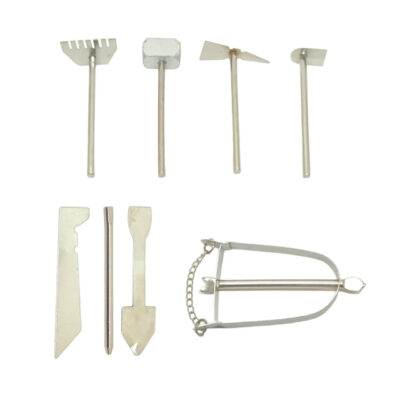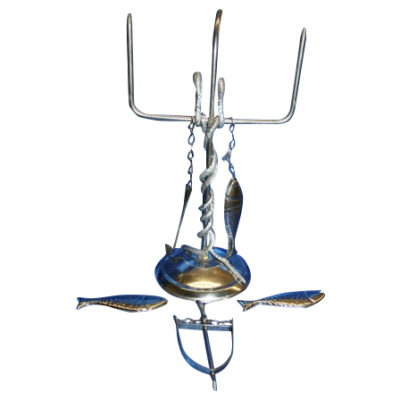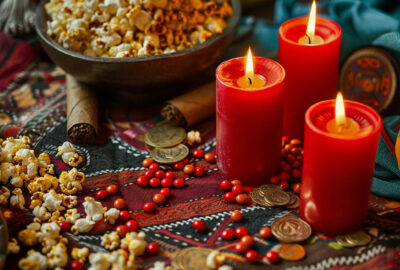
Orishas and Their Tools
When setting up an altar for an Orisha, it is wise to include the Orisha's tools. These tools, also called herramientas, represent aspects of the Orisha and the phenomena they govern. Most of the tools are a combination of traditional items familiar to the Yoruba people before the Transatlantic slave trade, and objects they encountered in the Americas. While not traditional parts of West African culture, objects like metal crowns, ox-drawn plows, and metal chalices all found their place among the tools of the Orishas.
By following your tradition and properly honoring your Orisha through the creation of an altar and the use of their traditional tools, you can strengthen your spiritual connection. Most Orishas have their own distinct set of tools, and a sopera to hold both the tools and fetish stones (otá). Some of these include:
Ogun's Tools
Ogun is invoked and venerated through various rituals and offerings, which may include the use of specific tools. Some of the traditional tools associated with Ogun include the oshe, a sacred drum; the adie, a double-headed drum; and the osisi, a staff or scepter. Ogun's symbols include the double-headed ax, a weapon that he is said to have wielded in life, and the iron rod, a symbol of his power and strength.
Oshun's Tools
Some of the traditional tools associated with Oshun include the efugo, a small gourd rattle that is used to accompany prayers and rituals; the ese, a wooden seat or stool that is used as a throne for the orisha; and the otun, a metal mirror that is used to reflect the light of the sun and is believed to possess the power to attract and radiate beauty. Her crown represents her sovereignty, while the lances that hang from it represent her protective nature. Her other tools, her oars, symbolizes her position as a river goddess, as well as the balance between tenderness and ferocity, and good and evil. Her soperas are yellow and gold ceramic, and her five yellow stones come from the Osun river.
Ochosi's Tools
Ochosi is honored and respected through various rituals and offerings that may involve the use of specific tools. Some of the traditional tools associated with Ochosi include the oshe, a sacred drum; the adie, a double-headed drum; and the osisi, a staff or scepter. Ochosi is also often associated with the color green and the number three, and his symbols may include the bow and arrow, weapons that he is said to wield with great skill and precision, and the alligator, a symbol of his power and cunning.
Shango's Tools
Shango is the god of battle and lightning, and his tools are traditionally made from the wood of his favorite tree, red cedar. As an invincible warrior, his tools reflect items used in battle -- an ax, oshe (double-headed ax), an arrow, a dagger, a machete, and a lance. Some of the traditional tools associated with Shango include the oshe, a sacred drum; the adie, a double-headed drum; and the osisi, a staff or scepter. His sopera is usually cedar wood, containing at least six thunderstones along with eighteen cowrie shells.
Inle's Tools
Inle is a hunter and healer who dwells where rivers meet the sea. His tools consist of a trident wrapped in snakes (similar to a caduceus or staff of Asclepius), three fish, a spear, and a bow. These represent prosperity, in the form of the bounty of the land and seas. His sopera is usually blue and green, and some of them cleverly incorporate fish motifs.
Yemaya's and Olokun's Tools
Yemaya is the beautiful goddess of the sea, while Olokun is often named as her husband, father, or sometimes even combined with her. As an ocean deity, Yemaya-Olokun's tools are frequently made of lead -- the only metal salt water will not corrode. Her tools are a moon, symbolic of her role as mother to the Orishas, and a sun, symbolic of power, life, and her ability to extinguish it. A pair of oars represent balance, while an anchor represents stability. A life preserver symbolizes her willingness to save those in need. Lastly, the mermaid represents her beauty and connection to the ocean's mystery.
One of Olokun's tools is a doll with a snake in one hand and a mask in the other, to represent life and death. Her soperas are predominantly blue or blue and white ceramic and contain seven black, smooth stones and eighteen cowries as well as her tools.
Using the Orishas' Tools
Skilled, experienced practitioners can use the tools of the Orishas as a type of sympathetic magic. Shango's weapons, for example, can be used to protect someone from harm and keep danger away, and Inle can bring wealth and prosperity. The methods for using them vary from tradition to tradition, and not all traditions or houses use the same tools for a given Orisha.
No matter what tradition you follow, it is important to build a relationship with an Orisha before doing this -- think of it as paying your dues before attempting to ask them for help. Place cups or bowls of fresh water on the altar, and change them daily. Light candles in the right colors. At least once a week, leave the appropriate food offerings on the altar. (Be sure to replace them if they begin to decay!)
The Orisha's tools empower them to help create change. They are physical symbols of the Orishas' power, and, through them, they can help bring you protection, healing, prosperity, beauty, love, and more. By working within your tradition to properly honor your Orisha, set up an altar, and provide them with the right tools and environment, you can strengthen your spiritual connection.













